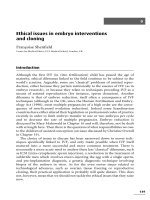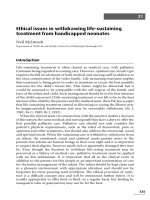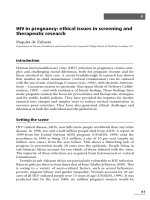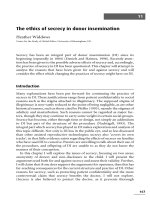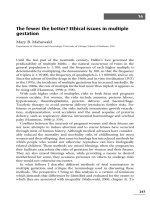The fewer the better. Ethical issues in multiple gestation
Bạn đang xem bản rút gọn của tài liệu. Xem và tải ngay bản đầy đủ của tài liệu tại đây (156.58 KB, 16 trang )
16
The fewer the better? Ethical issues in multiple
gestation
Mary B. Mahowald
Department of Obstetrics and Gynecology, University of Chicago School of Medicine, USA
Until the last part of the twentieth century, Hellin’s Law governed the
predictability of multiple births – the natural occurrence of twins in the
general population is 1/100, and the frequency of each higher multiple is
determinable by multiplying the denominator by 100, so that the frequency
of triplets is 1/10 000, the frequency of quadruplets is 1/1 000 000, and so on.
Since the advent of fertility drugs in the 1960s and in vitro fertilization (IVF)
in the 1970s, the incidence of multiple gestations has increased markedly. By
the late 1980s, the rate of multiple births had more than tripled; it appears to
be rising still (Hammon, 1998: p. 338).
With each higher order of multiples, risks to both fetus and pregnant
woman escalate. For women, the risks include anaemia, preterm labour,
hypertension, thrombophlebitis, preterm delivery and haemorrhage.
Tocolytic therapy to avoid preterm delivery introduces further risks. For
fetuses or potential children, the risks include intrauterine growth retarda-
tion, malpresentation, cord accidents and the usual sequelae of preterm
delivery, such as respiratory distress, intracranial haemorrhage and cerebral
palsy (Hammon, 1998: p. 339).
ConXicts between the interests of pregnant women and their fetuses are
not new; attempts to induce abortion and to rescue fetuses have occurred
through most of human history. Although medical advances have consider-
ably reduced the mortality and morbidity risks of childbearing for most
women and their oVspring, that same technology has introduced methods by
which people who would not otherwise reproduce can have biologically
related children. These methods are mixed blessings when the pregnancies
they facilitate exacerbate the risks of gestation for women and their fetuses.
They are also mixed blessings when, while providing a means to desired
motherhood for some, they occasion pressures on others to undergo risks
they would not otherwise encounter.
In what follows I describe diVerent methods of fetal termination in
multiple gestation, and critique the terminology used in discussing these
methods. The perspective I bring to this analysis is a version of feminism
which demands that diVerences be identiWed and evaluated for the extent to
which they are associated with inequality (Mahowald, 2000: chapter 4). To
247
illustrate a range of morally relevant variables, I sketch a number of cases,
both real and concocted, examining these from my egalitarian feminist
standpoint. I conclude that, while greater eVorts are needed to reduce the
incidence of multiple gestation, fetal termination with pregnancy preserva-
tion is justiWed in certain circumstances.
Methods of fetal or embryo termination in multiple gestation
According to one of its foremost practitioners, ‘Most cases of multiple
pregnancy are iatrogenic and avoidable by more diligent use of fertility drugs
and better patient management’ (Evans et al., 1997: p. 771). Although
iatrogenic practice has not been reported in the well-publicized cases
of the McCaughey septuplets and the Chukwu octuplets, we do know that
these gestations were initiated through use of fertility drugs, that at least
one newborn died and others suVered lasting impairment, and that the
women involved faced severe health risks with long-term adverse conse-
quences (Associated Press, 1998; Tribune News Services, 1999). We also
know that the high multiplicity of these gestations could probably have been
avoided, even after the administration of infertility drugs, if ultrasound
monitoring indicated maturation of multiple follicle cells (Manier, 1998:
p. 1). At that point, clinicians might have declined to administer a second
drug that would trigger the release of eggs. Alternatively or additionally, the
patient might have agreed to refrain from intercourse until her next cycle,
when the risk of multiple gestation would be reduced by modifying her drug
dosage.
Obviously, prevention of multiple gestation is desirable and can probably
be accomplished in most cases. As already acknowledged, however, the
possibility of high multiples occurs in nature, albeit rarely, and the mortality
and morbidity of these gestations for women and some of their fetuses can
only eVectively be reduced by terminating other fetuses. In other words, the
criterion on which to base the medical prognosis for women and their
potential children in multiple gestations is ‘the fewer the better’. How, then,
does one reduce many gestating fetuses or embryos to fewer?
An apparent, relatively easy answer occurs in the context of in vitro
fertilization, when higher order multiples can be avoided by declining to
transfer more than three or four embryos after fertilization, storing or
disposing of extra ones in some other way. In fact, this is the usual practice of
reproductive endocrinologists, who tend to consider higher order multiples a
failure rather than a success. The recommendation to transfer only three or
four is thought to strike a balance between the risk of multiples and the risk of
not achieving a pregnancy at all. This approach does not adequately answer
the question raised, however, because multiple gestations are still possible,
248 M.B. Mahowald
regardless of whether fertilization occurs in vitro or in vivo. Moreover, the
disposition of untransferred embryos poses additional questions, which I
have addressed elsewhere (Mahowald, 2000: chapter 12).
Current techniques by which to limit the number of embryos or fetuses in
a multiple pregnancy involve either direct termination or removal of in vivo
embryos. The removal procedures are performed through transcervical suc-
tioning at 8 to 11 weeks’ gestation or through transvaginal aspiration usually
at six to seven weeks’ gestation. Unfortunately, the transcervical technique is
associated with a high (50 per cent) incidence of total pregnancy loss, and the
transvaginal technique precludes rudimentary detection of anomalies such as
nuchal folds (suggestive of Down’s syndrome). Transvaginal aspiration also
precludes the possibility of spontaneous loss of embryos, which could make
further termination unnecessary. (Some practitioners of transvaginal aspir-
ation wait until about 10 weeks so as to allow for spontaneous loss, but the
approach is more diYcult and risky at that point.) In the light of these
limitations, the most common method of terminating some of the embryos
or fetuses in a multiple gestation is direct termination at 9 to 12 weeks
through transabdominal needle insertion of potassium chloride into the fetal
thorax; the goal of this procedure, to ‘achieve cardiac standstill’, is later
conWrmed (or otherwise) by ultrasound (Evans et al., 1997: p. 772). If cardiac
function has not ceased, the procedure may be repeated.
As in the preceding paragraph, the terms fetus and embryo are used
interchangeably in discussions of this issue because the distinction between
embryos and fetuses is not cleanly deWnable by duration of gestation. Some
authors (e.g. Grobstein, 1995) use the term ‘pre-embryo’ for the embryo that
has not yet implanted in the uterus. I Wnd this term misleading because it
suggests, inaccurately, that the genetic material essential to development has
not yet been assembled in the newly fertilized organism (cf. Mahowald,
1995b).
Eight weeks of gestation is often stipulated as the threshold between
embryonic and fetal development, but this is a broad generalization. Cardiac
function begins weeks earlier and lung function or kidney function much
later. In general, embryonic development starts at fertilization and continues
until all components of the basic organ system are initiated; fetal develop-
ment consists mainly of their elaboration. Depending on the duration of a
multiple gestation, then, procedures for reducing the multiple may involve
embryos or fetuses. Because common parlance often uses the term fetus to
describe the developing organism from fertilization to birth, I will hereafter
also do that.
249The fewer the better?
More on terminology
The language used to name procedures to reduce the number of developing
fetuses in an established gestation is controversial in its own right. Among the
terms utilized are selective birth, selective abortion, selective reduction, fetal
reduction and multifetal pregnancy reduction (Berkowitz et al., 1996).
Others that could be utilized are partial abortion or partial feticide. The term
‘selective birth’ has been used for cases of multiple gestation in which a
speciWc fetus had been identiWed as anomalous and targeted for termination.
(Targeting could occur for other reasons, such as sex selection.)
Prenatal detection of the anomaly is not possible until weeks, sometimes
months, after detection of the number of gestating fetuses. Ultrasound
guided cardiac injection of the targeted fetus is then the means through
which termination is accomplished. Obviously and perhaps misleadingly, the
term ‘selective birth’ focuses on the fetuses that are not targeted. ‘Selective
abortion’ would more accurately describe the procedure, but only if abortion
is deWned as termination of the fetus rather than termination of pregnancy.
‘Selective reduction’ is accurate if speciWc fetuses are targeted and if the
pregnancy itself is not thought to be ‘reduced’. But women, after all, are
neither more nor less pregnant, regardless of the number of fetuses they are
carrying. What is reduced, therefore, is the number of gestating fetuses. In
situations in which selective reduction of fetuses occurs, the actual procedure
is direct termination of the targeted fetus or fetuses. In these cases, ‘selective
termination’ would be a more accurate representation of what is intended
and done. If abortion is deWned as termination of the fetus rather than
termination of a non-viable pregnancy, ‘selective abortion’ would be accurate
when speciWc fetuses are targeted and ‘partial abortion’ would be accurate in
other cases as well. (Clinical texts usually deWne abortion as termination of a
non-viable pregnancy; popular understandings tend to identify it with termi-
nation of fetuses. Cf. Mahowald, 1982.) If abortion is deWned as termination
of a (non-viable) pregnancy, terminating one fetus while maintaining the
pregnancy through another (or others) is not equivalent to abortion.
Years ago I used the term ‘fetal reduction’ to describe interventions to
reduce the number of developing fetuses in multiple gestations (Mahowald,
1993: pp. 87–90). I now consider the term ‘reduction’ misleading or ambigu-
ous. It is misleading because it obscures the fact that the procedure in most
cases entails direct killing of at least one fetus, and in other cases makes it
impossible for some fetuses to survive, which to many is morally equivalent
to killing. It is ambiguous because ‘reduction’ is not equivalent to ‘termina-
tion’. Although ‘termination’ is the more honest description, a fair and
adequate deWnition of the procedure needs to include the aim of maintaining
the pregnancy by preserving some fetuses.
‘Multifetal pregnancy reduction’ is the term most commonly used by those
250 M.B. Mahowald
who perform the procedure (e.g. Berkowitz et al., 1996: p. 1265; Rorty and
Pinkerton, 1996: p. 55; Evans et al., 1997: p. 771). It is also the vocabulary
preferred by the American College of Obstetricians and Gynecologists. This
terminology, however, raises some of the same problems cited above –
pregnancy is not reducible, and even if it were, the term ‘reduction’ mis-
characterizes the intervention. To be adequate, a deWnition of the procedure
would indicate that it involves terminating fetuses while preserving preg-
nancy. Awkward but accurate deWnitions could therefore be any of the
following: fetal termination with pregnancy preservation; fetal termination
and preservation in multiple gestation; reducing the number of fetuses in
multiple gestation; abortion with pregnancy preservation; and partial abor-
tion. As already suggested, the last two deWnitions are only accurate if
abortion is deWned as termination of the fetus rather than termination of
pregnancy. Hereafter, I will use the Wrst deWnition, which I consider simplest,
clear and accurate – fetal termination with pregnancy preservation, which I
will shorten to FTPP.
Egalitarian feminism and FTPP cases
An egalitarian version of feminism gives priority to equality, broadly con-
strued, as an ethical consideration. Individual liberty may therefore be
subordinated to other goods in order to render the diVerent capabilities of
individuals as equal as possible – for example, in Amartya Sen’s notion of
equality of capability (Sen, 1995). But what are the capabilities to be con-
sidered with regard to FTPP and to whom do they belong?
DiVerent capabilities belong to diVerent individuals whose interests may
be promoted or impeded through FTPP. Although fetuses are not legally
persons, and their personhood is morally debatable, they are in fact living,
human and genetically distinct from the women in whom they develop.
Many human fetuses have the capability of becoming persons both legally
and morally. In high order multiple gestations, however, that capability is so
greatly and unalterably reduced (without intervention) that the scenario is
morally diVerent from, say, a twin gestation, where the capability of both
fetuses becoming legal and moral persons is high. The following cases
illustrate this morally relevant diVerence along with other variables that
inXuence the capabilities of individuals. Consideration of these variables is
crucial to ethical decisions about whether FTPP should be requested or
performed. Case 2a is one in which I was personally involved; case 3a is the
well-publicized case of the McCaughey septuplets. Although the other cases
are Wctitious, all of the features enumerated have occurred in real cases.
∑ Case 1a: Normal twins – during her second prenatal visit, a 36-year-old
mother of Wve children, aged 2 to 12 years, is told that she has a twin
251The fewer the better?
gestation. She tells her doctor that she thinks she can handle a single
newborn but not two at once. ‘I simply don’t have time for twins’, she says.
Having heard about FTPP, she asks whether this is an option for her. The
alternative of adoption is suggested but rejected. The woman has the
Wnancial resources to cover the costs of FTPP.
∑ Case 1b: Same case as 1a except that one fetus has Down’s syndrome.
∑ Case 1c: Same case as 1a except that one fetus has trisomy 13.
∑ Case 1d: Same case as 1a except that the woman cannot pay for FTPP.
∑ Case 2a: Infertility drug + twin gestation – an aZuent childless woman
undergoing infertility treatment for two years becomes pregnant after
taking Perganol. She has been told that this drug might cause multiple
gestation. At eight weeks’ gestation, ultrasound conWrms the presence in
utero of two fetuses, both of which appear healthy. One week later, the
woman asks her physician to reduce the number of fetuses to one. Al-
though the patient is informed that this procedure involves risk of losing
the other fetus also, she persists in her request for FTPP, indicating that if
this cannot be done, she will seek abortion of both fetuses, and ‘try again’
for another pregnancy.
∑ Case 2b: Same case as 2a except that the twins are known to be a male and a
female, and the woman asks the physician to target the female fetus.
∑ Case 2c: Same case as 2a except that the woman asks the physician to target
the male fetus.
∑ Case 2d: Same case as 2a except that the woman has a triplet gestation and
wants to have a singleton.
∑ Case 2e: Same case as 2a except that the physician has never performed
FTPP.
∑ Case 3a: Infertility treatment and high-order multiples – after having a
daughter with the assistance of a fertility drug (Metrodin), Bobbi
McCaughey asks her doctor for similar assistance to have a second child.
Six weeks later, ultrasound shows that she is carrying septuplets. Doctors
present the option of FTPP as a means by which to optimize the chance of a
live healthy birth of at least one child. The option is rejected on grounds
that it is morally equivalent to abortion.
∑ Case 3b: Same as 3a except that fertilization occurs in vitro, allowing
transfer of fewer embryos.
∑ Case 4: Quadruplet gestation after IVF or natural fertilization.
From an egalitarian feminist standpoint, the variables in the above cases need
to be identiWed because they are sometimes associated with inequality or
unjust discrimination. The variable of ability to pay, for example, expands the
options of some women while restricting those of others; it may thus
exemplify classism. Targeting disabled fetuses or fetuses of a speciWc sex
suggests unequal regard for one individual or group as opposed to another; it
252 M.B. Mahowald




